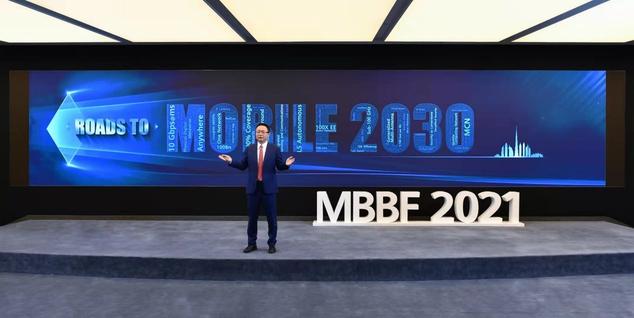This reference material is a translated version of a press release released in Dubai, United Arab Emirates on October 13, 2021 (local time).
Huawei Japan (Corporate) [October 13, 2021, Dubai, Arab Emirates] Huawei (Chinese) at the 12th Global Mobile Broadband Forum (MBBF) held in Dubai from October 13, 2021. Notation: Huawei Technology, English notation: HUAWEI) Senior Managing Director and President of ICT Products & Solutions, David Wang, entitled "Towards Mobile 2030: 10 Trends in the Mobile Communications Industry" I gave a lecture. In his speech, Mr. Mio said, "The next 10 years will be a decade toward an intelligent world. Wireless networks will be an important pillar to support it. With that in mind, Huawei has predicted 10 trends in the mobile industry, and we hope to take this opportunity to work with industry to think about future wireless networks and build an intelligent world. "Mr. Mio giving a keynote speech at MBBF 2021
By 2030, the digital and physical worlds will seamlessly integrate to enable perceptual and emotional interactions between humans and machines. On the business side, the digital economy will become the mainstay of the economy, and the industry will shift its focus from equipment effectiveness to decision-making efficiency. However, the environment will remain a key challenge for the next decade as it is based on green growth and cybersecurity. In light of these changes, Huawei has compiled 10 industry trends for the next decade of mobile networks, which will be an important part of the concept of Intelligent World 2030. Trend 1: Toward the 10GE intelligent world 2030, which bridges the physical world and the digital world, the reality is that hearing, sight, touch, and smell are fused and exchanged as mobile communication networks become more sophisticated. As a result, people's communication and information exchange will become deeper and wider. For this reason, it is necessary to realize 10 Gbit / s communication everywhere in mobile networks with a delay time of the millisecond level, and to further make the transmitted information more semantic. Trend 2: Achieve 100 billion IoT connections in all scenarios with one network Wireless networks are expected to support 100 billion IoT connections by 2030. To build an all-scenario IoT network, it is necessary to provide a wide variety of connection services according to communication speed and priority requirements. We need to build a new form of wireless IoT that provides a low latency, reliable experience and features ultra-low power consumption and passive connectivity. Trend 3: 3D Coverage Satellite-Ground Collaboration Satellite-ground collaboration fills the shortage of terrestrial wireless coverage, provides 3D coverage, and supports future unmanned and aircraft communications and control. Mobile networks with existing advanced communications technologies and trillions of dollars markets will also be used to foster new satellite communications technologies and develop industries. Trend 4: Realize true digital replication through the fusion of sensing and communication technologies The advanced fusion of communication and sensing enables real-time digital replication of the physical world, supporting advanced autonomous driving and unmanned aerial vehicle management. increase. An efficient fusion of communication and sensing also requires a consistent wireless interface and network architecture. In addition, wideband, Massive MIMO technology needs to improve the spatial resolution of the sensor to the centimeter level. Trend 5: Intelligence Connects to All Industries By 2030, wireless networks will be highly integrated with AI technology, making Level 5 fully autonomous driving networks a reality. This enables O & M automation, significant performance improvements, and minimizes carbon dioxide emissions. Future radio interfaces will be designed with native intelligence, and intelligent radio algorithms will further optimize channel coding and radio resource management. Trend 6: Full-link, full-life cycle green network Network traffic is expected to increase 100-fold by 2030. Therefore, network energy efficiency will need to be improved as well. To achieve this, energy efficiency must be considered in every aspect of network design, including wireless interfaces, devices, and base stations. This will enable us to build a green and sustainable network of full links and full life cycles. Trend 7: Flexible use of full-band sub 100 GHz By 2030, countries will need an average of 2 GHz medium bandwidth and millimeter-wave bandwidth above 20 GHz to accommodate increasing traffic. In the future, it will be necessary to promote NR in the sub 100GHz band and review frequency usage, such as achieving 10 times the frequency utilization efficiency through innovative technologies such as multi-band. Trend 8: General-purpose multi-antenna to reduce cost per bit As multi-antenna technology begins to be applied to all frequency bands and scenarios, data transmission costs per bit will continue to decrease. Ultra-wideband modular antennas support flexible combinations of multi-bands, and advances in Intelligent Reflecting. Surface (IRS) technology allow multi-antenna technology to be applied in more scenarios for cloud-based deployments. It will be possible and you will get higher performance. Trend 9: Security is the foundation of the digital future With the focus on network security and resiliency, the importance of unique security at the device layer and intelligent and simple security at the network layer is increasing. Through cloud-network integration, operators can deliver simplified, one-stop security services to their customers. Trend 10: Mobile computing networks for device-network-cloud integration Future mobile networks will support a wider variety of services, including Metaverse, industrial field networks, and vehicle-to-vehicle communication (V2X). A single service model is not enough to build a new digital platform, so mobile computing networks need to provide seamless, high-quality services on demand in real time. Finally, Mr. Mio concluded the lecture as follows. "I think we have taken a new step by announcing 10 trends in mobile networks for the next decade. Huawei will work with the industry as a whole to realize the intelligent world 2030." For more information, see "10 Trends White Papers for the Next 10 Years in the Wireless Networking Industry." https://www.huawei.com/en/technology-insights/industry-insights/outlook/mobile-2030-10-wireless-industry-trends- Press Release>
- Huawei Japan (Corporate)>
- Huawei predicts trends for the next 10 years with "Roads to Mobile 2030"
- kinds
- event
- Business category
- Network Network Equipment Application Security
- keyword
- Related URL
- https://www.huawei.com/en/technology-insights/industry-insights/outlook/mobile-2030-10-wireless-industry-trends




